
All categories
Featured selections
Trade Assurance
Buyer Central
Help Center
Get the app
Become a supplier

(7 products available)






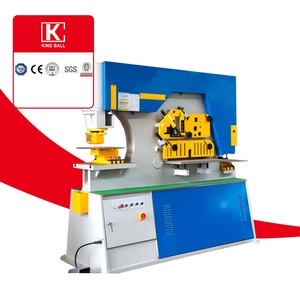










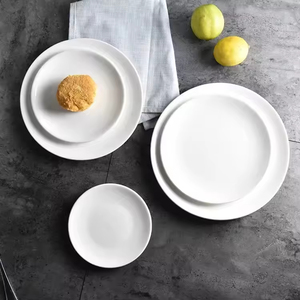










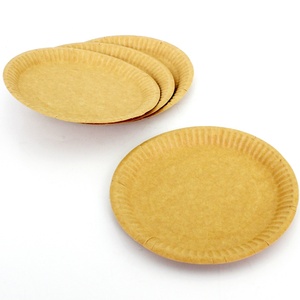

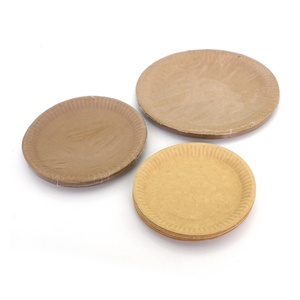







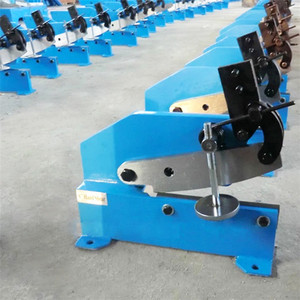
A mesin potong plat besi or metal shearing machine is a necessary tool for anyone working with steel plates. This includes construction companies, metalworking shops, and manufacturers of metal products. The machine uses a shear blade to cut through metal quickly and accurately. Different types of machines are available in the market, and each serves a different purpose. Here are the common types of metal shearing machines:
Hydraulic Shear Machine
This machine uses hydraulic power to operate the blades. Hydraulic fluid is pumped into cylinders, causing the blades to move and cut the metal. Hydraulic shear machines are known for their high cutting force and precision. They can cut through thick and heavy plates of metal quickly. The machine is widely used in metal fabrication shops and industries where large quantities of metal plates are cut. It is easy to control and can be programmed to make different cuts.
Mechanical Shear Machine
A mechanical shear machine uses a mechanical system of gears and levers to power the cutting blades. The system converts the mechanical energy into cutting force, which moves the blades to shear the metal. This machine is known for its speed and efficiency when cutting lighter gauges of metal. It is less expensive to maintain and operates with a shorter hydraulic shear machine price. However, it may not be as precise as the hydraulic machine when cutting thicker metals.
Guillotine Shear Machine
This machine is designed to cut straight lines in metal sheets or plates. It has a design that resembles a guillotine with a fixed blade and a moving blade that cuts the metal when it is pressed down. The guillotine shear is suitable for cutting large sheets of metal with high precision. It is widely used in industries that require large-format cutting, like the shipbuilding industry. The machine can be hydraulic or mechanical depending on the design.
Plasma Shear Machine
The plasma machine uses a plasma torch to cut the metal. It works by ionizing the air and creating a high-temperature plasma arc that melts and cuts through the metal. Plasma shears are known for their speed and ability to cut intricate shapes and designs. They are suitable for thinner gauges of metal and are often used in CNC plasma cutting systems. The machine requires more technical knowledge to operate than hydraulic or mechanical machines.
Both of the machines described above are equipped with various features to improve cutting accuracy and efficiency. Some of these features include:
CNC Control
The CNC flame cutting machine has a computer numerical control system. This control system automates the cutting process. It improves the accuracy and efficiency of cutting metal sheets. The CNC system controls the track of the cutting torch. This ensures that there is a precise and consistent cut along the desired trajectory. The user can program complex shapes and designs into the system. As a result, there is a reduction in human error and waste material.
Plasma Cutting Head
The cutting head is an important feature of a plasma cutting machine. It consists of a nozzle and an electrode. The plasma cutting head focuses the plasma arc on the metal sheet. This creates a small and intense heat that melts the metal. The molten metal is then blown away by the plasma. The cutting head can be moved along the X and Y axes. This allows it to cut out complex shapes and designs from the metal sheet.
Bevel Cutting Capability
Bever cutting capability is an important feature of a CNC plasma cutting machine. Bevel cutting is the ability to make angled cuts on the edges of metal plates. This allows for better weld penetration and a smooth finish. The bevel cutting attachment consists of a height control sensor and a specific cutting head. The height control sensor ensures that there is a constant distance between the cutting torch and the metal sheet. This ensures accurate bevel cuts.
Water Jet Cutting Bed
Water jet cutting beds are equipped with an abrasive water jet cutting system. This system consists of a powerful pump that generates high-pressure water. It also consists of a mixing chamber and a cutting head. The pump generates water at a pressure of 60,000 psi. The water is mixed with abrasives such as garnet in the mixing chamber. This forms a high-velocity jet of water. The water jet is then directed onto the metal sheet through the cutting head. The jet pierces through the metal sheet with high precision.
Construction Sites:
Cutting Steel Plates for Structural Components: Construction sites often use mesin potong plat besi to cut steel plates used for beams, girders, and trusses. These structural components provide stability and support to buildings and other structures.
Fabrication of Columns and Posts: These machines are used to cut steel plates that are welded or assembled into columns and posts. These machines provide vertical support and load-bearing capacity in construction projects.
Creating Steel Frames: Mesin potong plat besi are used to cut steel plates that are assembled into frames for structures like warehouses, factories, and agricultural buildings. Steel frames provide a durable and flexible structural system.
Manufacturing Plants:
Machinery and Equipment Production: In manufacturing plants, mesin potong plat besi are used to cut metal plates used in the production of various machinery and equipment, such as tractors, excavators, and industrial machines.
Container and Trailer Manufacturing: These machines are used to cut steel plates for fabricating containers and trailers. Steel plates are essential in constructing the bodies and frames of these transport vehicles.
Custom Metal Fabrication: Manufacturing plants often have custom metal fabrication projects where mesin potong plat besi are used to cut steel plates into various sizes and shapes to meet specific customer requirements.
Automotive and Aerospace Industries:
In the automotive and aerospace industries, mesin potong plat besi are used to cut metal plates for various applications, including chassis, frames, and body components of vehicles and aircraft. Precision cutting is essential to ensure proper fit and function.
These machines are also used to cut metal plates for manufacturing landing gear, wings, fuselage, and other aircraft components. Accurate cuts are crucial for the safety and performance of these aircraft parts.
Metal Workshops and Fabrication Facilities:
Metal workshops and fabrication facilities utilize mesin potong plat besi to cut steel plates for a wide range of metalworking projects. These machines provide flexibility and precision in cutting plates to required dimensions and shapes.
They are also used for repairing and maintaining existing metal structures and components by cutting matching plates for weld repairs or replacements.
Assess the Cutting Needs:
Determining the type and thickness of the plates that need to be cut is essential. If the requirement involves cutting thin sheets of metal (up to 3 mm), a shear or nibbling machine may suffice. However, for thicker plates (up to 10 mm), a mesin potong besi with a guillotine shear or a more robust nibbling machine would be ideal. For plates over 10 mm, electric or hydraulic metal cutting saws are recommended. Additionally, consider the type of metal—mild steel, stainless steel, or aluminum—as certain machines perform better with specific materials.
Evaluate Safety Features:
Safety should be paramount when choosing a cutting machine. Look for machines equipped with emergency stop buttons, protective covers, and safety sensors. These features can prevent accidents and injuries during operation, especially when working with heavy and sharp materials.
Examine Machine Durability and Build Quality:
It's crucial to assess the durability and build quality of the cutting machine. Opt for machines constructed with high-quality, durable materials like hardened steel or reinforced plastic. Such materials ensure longevity and reliable performance over time, even under heavy use.
Consider the Ease of Use and Maintenance:
Choose cutting machines that are easy to operate and maintain. Look for models with user-friendly interfaces, clear instructions, and easy-to-access parts for regular maintenance. This not only saves time but also ensures the machine operates at peak efficiency for an extended period.
Check for Customization and Scalability Options:
It's best to select a cutting machine that offers customization and scalability options. This ensures that the machine can adapt to different cutting requirements and business growth in the future. Such flexibility is critical in a rapidly changing industrial landscape.
Evaluate Technical Support and Warranty:
A robust technical support system and comprehensive warranty are vital when investing in a cutting machine. Ensure the supplier offers 24/7 technical assistance and a warranty covering critical machine parts. This provides peace of mind and assures prompt solutions in case of technical hitches.
Q1: What are the safety precautions for cutting steel plates?
A1: Some of the safety precautions include wearing the right personal protective equipment; industrial-grade gloves and a face shield. Users should also inspect the tools and equipment for any defects before use. They should avoid loose clothing and jewelry when operating the cutting machine. Lastly, users should follow the manufacturer's instructions and guidelines.
Q2: What is the steel plate cutting machine used for?
A2: A steel plate cutting machine is used to cut various types of steel plates. It is widely used in construction, manufacturing, and metalworking industries. The machine provides accurate and efficient cuts, producing steel plates of different sizes and shapes that meet specific requirements.
Q3: What is the minimum thickness that can be cut on a metal cutting machine?
A3: The minimum thickness of the metal plate that can be cut depends on the type of cutting machine. For flame cutters, the minimum thickness is 10mm, while for plasma cutters, it is 8mm. However, some machines can cut plates with a thickness of up to 1mm. The minimum thickness also depends on the machine's cutting speed.
Q4: What are the common types of steel cutting machines?
A4: The common types of steel cutting machines include flame cutting machines, plasma cutting machines, and laser cutting machines. Other types are band saw cutting machines and circular saw cutting machines.
Q5: What are the factors to consider when choosing a steel cutting machine?
A5: Some of the factors to consider include the type of material to be cut, the size and thickness of the material, the cutting precision required, and the available budget. Users should also consider the machine's ease of use and maintenance, as well as the manufacturer's reputation and customer support.